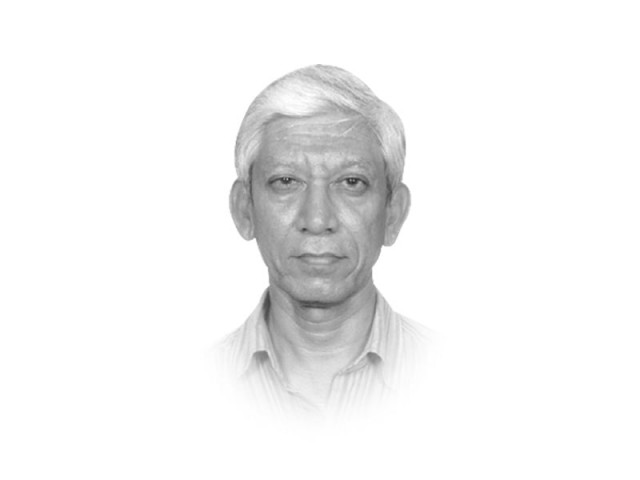‘Them’ and ‘us’
Break up of the two wings of the country was a price the powers had cynically agreed to impose on people of Pakistan.

The powers that had been running the affairs of the country almost from its inception showed as little respect to the democratic mandate in 1971 as they have been displaying since. As the primary function of any government — elected or otherwise — is control of the country’s resources and their allocation to various sections of the national economy according to its own preferences, respecting the people’s mandate would mean transfer of the control to their elected representatives. It would also mean a basic change in the national goal from security to economic progress. And this was one thing that the powers that be were not willing to do — nor are they any more willing to do so even today. Therefore, they found it in their interest to let the people’s aspirations degenerate into a situation of two nationalisms warring with each other. The section of the population of East Pakistan — including ethnic Bengalis and the Urdu-speaking Biharis — that had voted for the defeated pro-centre and religious political parties was thus co-opted and aligned against the other section which had voted for the Awami League. The break up of the two wings of the country from each other — and the blood that was to flow in the process — was a price the powers had cynically agreed to impose on the people of Pakistan.
Seeing from the point of view of Mohammad Siddiq Bilwani, the dynamics of the civil war show a resemblance with the murderous events of 1947. He narrates an interesting incident involving what could in today’s parlance be called a non-state actor, a participant in the communal riots that occurred on both sides of the border that divides Pakistani and Indian Punjab. Bilwani says that his family had started two cloth shops at Anarkali and Kashmiri Bazar in Lahore. By 1949 there was no passport between the two newborn states and traders could deal with each other without any restrictions. At the Wagah border, which was 17 miles away from one of his shops, Pakistani and Indian businessmen would exchange their wares and make payments in their country’s respective currency. Once a parcel of cloth got stolen from a shop where Bilwani had left it for safekeeping. The next day, he saw his cloth being sold at another shop. He registered a complaint with the Naulakha police station which raided the shop selling stolen cloth and found that they had bought it from a character called Chitta — the fair-skinned one. Chitta was arrested but quickly set free without any action against him. Bilwani was told that since Chitta was in fact a ‘ghazi-mard’ who had protected some Muslim families during the mayhem accompanying the Partition, he could not be touched.
Bilwani also mentions Younus Matka, who actively participated in the 1971 civil war. He led the Pakistani forces to many places where, according to him, warriors of the other side were hiding. This kind of help was most needed by the members of the forces who did not know the situation on the ground but had the means to kill and maim the ‘enemy’ once he had been pointed out to them. The razakars belonging to Al-Badr and Ash-Shams did more than just that as they had been armed and were able to do some of the killing and maiming themselves. There were the same kind of warriors on the other side as well, who took charge of the situation and treated their enemies in the same way. Once the situation flares up into a civil war, the unarmed people on both sides of the divide are required to provide the necessary moral support to their armed saviours – whether they are called ghazi-mards, mukti-joddhas, razakars or whatever. They are also required to suffer the consequences. The wedge driven between two sections of a human community in such traumatic times survives the war and leaves a stubborn, lasting enmity. The reverence shown to the warriors of the winning side — the victory may be defined in various ways to create different kinds of nationalisms — and the bitter treatment meted out to those of the defeated side is the price to be paid by the people in the long-term.
In order to see the 1971 tragedy on human scale, first-hand personal accounts are indispensible, because it is one person’s narrative — on whichever side that person may be on — that reveals the cracks in the seemingly seamless ‘national’ narratives that are constructed during and after the traumatic events. I came across on such atypical narrative in a diary of a Dhaka University student belonging to Lahore that records his personal experiences from March to June 1971. Anwer Shahid, who went on to become a journalist, wrote and managed to smuggle his diary to West Pakistan when he returned to Lahore in July 1971. I was surprised to learn that his diary, titled Padma Surkh Hai, was published as a series – under a pseudonym “Shaakh” – in the Lahore daily Musawat in November 1971; a journalist decided to translate and publish its installments in Karachi’s Gujarati daily Dawn.
Published in The Express Tribune, January 7th, 2012.















COMMENTS
Comments are moderated and generally will be posted if they are on-topic and not abusive.
For more information, please see our Comments FAQ